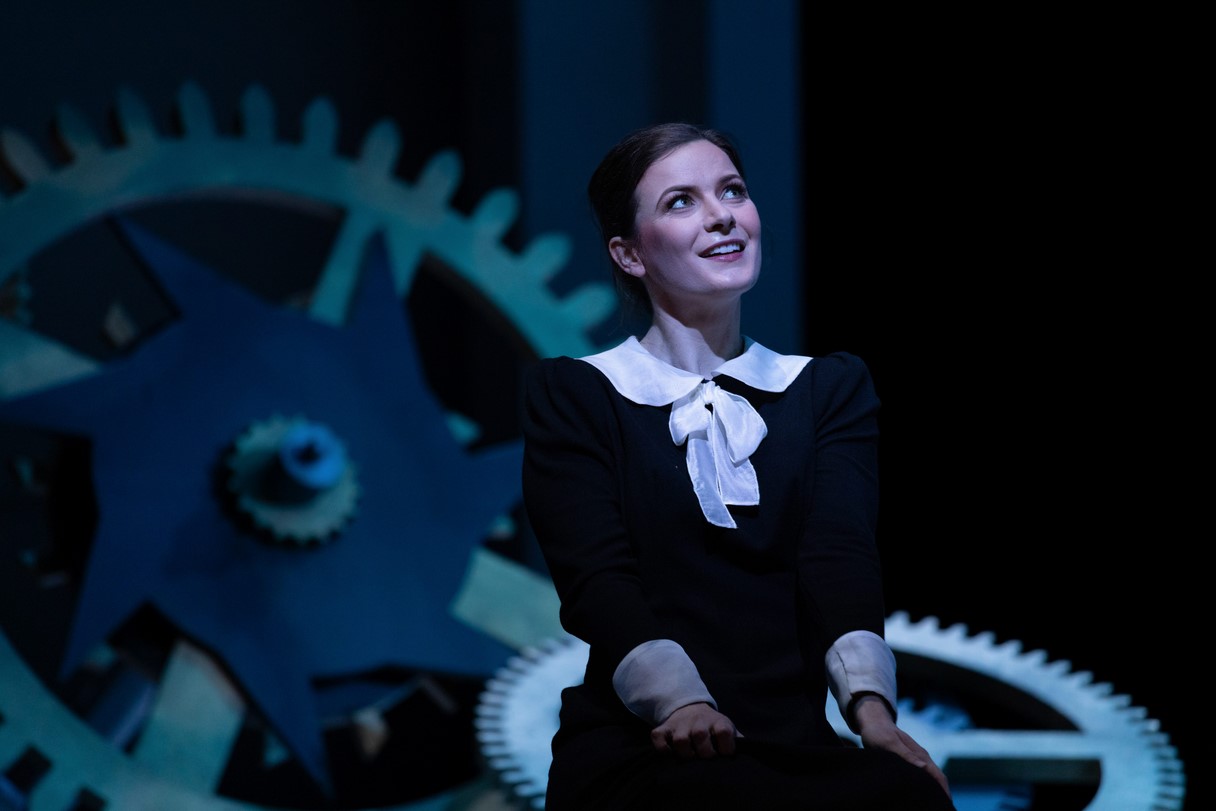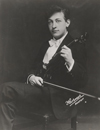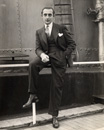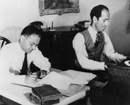Reviews
Santa Fe's New Figaro: Perfect Timing
SANTA FE—The plot of The Marriage of Figaro can feel like a dizzying maze of deceptions and deferred revelations—its intricate turns threatening to overwhelm the human stakes. But in Santa Fe Opera’s ingeniously paced staging, directed by Laurent Pelly, every complication slips neatly into place with the precision of a fine timepiece, allowing the machinery of the plot to bring the messy human entanglements into sharp relief.
Clock imagery, in fact, serves as the framing visual motif for this irresistibly clever production. Chantal Thomas’s set juxtaposes a giant set of interlocking gears on stage left with a black-and-white storybook rendering of the many-roomed, sparsely furnished palace. The mechanism sets the entire structure spinning atop a circular platform—like a mechanical toy springing to life—conveying a sense of time in constant motion across the single day in which Figaro unfolds.

L - R: Liv Redpath (Susanna), Florian Sempey (Count Almaviva), Riccardo Fassi (Figaro)
During the overture, each member of the cast takes a place along the platform’s rotating edge. But by Act IV, just as everyone assumes their schemes are about to pay off, this carefully ordered world has tipped into entropy. The night garden is littered with fragments of a broken-down system.
Doing double duty as costume designer, Pelly dresses the cast in attire that hints at Franco-era Spain of the 1930s, with the servants in crisp, tidy uniforms while the nobility lounges in colorful silk dressing gowns —a nod to Figaro’s underlying themes of hierarchy and control.
Dramedy in motion
Yet despite the clear markers of class, this production suggests that everyone is swept into the same circular machinery of desire and intrigue. That concept is reinforced by a youthful, high-energy cast whose ensemble spirit and tightly coordinated performances keep Figaro spinning with momentum—and sparks of both mischief and poignancy.
At the July 31 performance, Riccardo Fassi infused Figaro with comically exaggerated gestures, channeling silent-film slapstick antics. A tall, lithe figure, he compensated for a lack of low-end vocal ballast with a buoyant presence and deft comic timing. Crucially, he made us believe in Figaro’s love for Susanna with his glimpses of tenderness and unguarded affection, grounding their sparring with a sense of real emotional stakes.

Liv Redpath as Susanna in the Santa Fe Opera's new production of The Marriage of Figaro
That connection was made all the more convincing thanks to Liv Redpath, who delivered an engaging role debut as Susanna. With her nimble soprano and natural stage presence, she brought a winning combination of charm and quiet independence to the ever-resourceful young bride. Among many highlights was her Act IV serenade in disguise as the Countess, where she blended radiant tone with a playful sense of theatricality, striking just the right balance between sincerity and disguise.
As the Countess, Ailyn Pérez instantly shifted the tone from comedy to another level with gorgeously nuanced phrasing in the her first aria, in which time itself seemed to stretch to accommodate her longing. Her ”Dove sono” carried even greater pathos, unfolding with aching regret before blossoming into a sensual sense of hope reawakening.
Pérez’s rapport with Redpath was equally compelling, and the Letter Duet brought their alliance into vivid focus—musically and emotionally. Her bestowal of forgiveness in the final scene stilled the plot’s relentlessly revolving gears, allowing a final moment of spontaneous humanity to shine through.
As Count Almaviva, Florian Sempey complemented his rich, pliant baritone—on fine display in the longer, revised versions of his third-act aria—with a restless and imposing physicality. He summoned plenty of imperious bluster but tempered it with flashes of uncertainty and frustration, hinting at a deeper realization that his authority—once absolute—was being outpaced by those around him.
The lovesick lad
 Mezzo-soprano Honing Wu [right] was a standout as Cherubino, imbuing the lovesick lad with a mercurial impishness that didn’t preclude moments of touching sincerity. Her agile singing and quicksilver stage presence captured the page’s adolescent swirl of confused feelings.
Mezzo-soprano Honing Wu [right] was a standout as Cherubino, imbuing the lovesick lad with a mercurial impishness that didn’t preclude moments of touching sincerity. Her agile singing and quicksilver stage presence captured the page’s adolescent swirl of confused feelings.
Lucy Schaufer (Marcellina) and Maurizio Muraro (Bartolo) conspired with hilariously exaggerated gusto, making their attempted subterfuge of Figaro’s marriage—and the sudden unraveling of their plot in the recognition scene—a riotous delight. Steven Cole’s Basilio dripped with camp and innuendo, adding another layer of comic mischief to the mix.
Nicely etched cameos by soprano Isobel Anthony as Barbarina and bass-baritone Mattia Venni in the role of her father, the perpetually inebriated gardener Antonio—both Santa Fe Opera apprentice singers—attested to the strength of the company’s young artists program.
The engine driving all this intricate stagecraft was Harry Bicket’s wonderfully detailed musical direction, alive to every shift in nuance. Resisting the temptation to rush, he let phrases breathe, while the inner voices of Mozart’s score emerged with tender expressiveness—with special kudos to the Santa Fe Opera Orchestra woodwinds for their characterful, eloquent phrasing.
In tandem with Pelly, Bicket shaped a Figaro that made the perfectly balanced inner workings of Mozart’s music transparent—like the visible gears of a that timepiece—yet let them hum with the unpredictable, irregular heartbeat of human feeling.
Photos by Bronwen Sharp for the Santa Fe Opera





 FEATURED JOBS
FEATURED JOBS

 RENT A PHOTO
RENT A PHOTO


